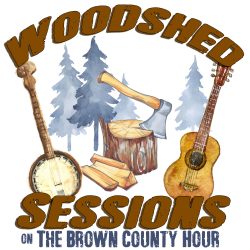
by Dave Seastrom, BCH Producer and unabashed tree-hugger
Becky and I live right next to “ground zero”. Soon the chainsaws, skidders, and dozers will have their way with this once pristine forest and this track will become a product of the new forest plan. I use the word product because that’s the way the state sees this land, as a commodity.
I was thinking about all of this as I weed whacked a clearing in the grassy area where the Bio-Blitz will take place this weekend, at The Weaver Plantation off of Low Gap road.
The weather was perfect for this activity, cool and cloudy. As I worked, I reflected on clearing this same area during high summer, in the blazing heat and full sun. Everyone was hot, but the dedication of the scientists, and the belief our work has real meaning, keep spirits high.
Tuesday night I listened to an interview with the head state forester with the DNR, John Siefert. I was very impressed with his smooth delivery, and the cool detached way he offhandedly spun a revised history of the new forest plan. If I didn’t know better, based on this interview, I would assume the forest is being properly managed.
Mr Siefert refused to appear with anyone who would challenge his view points, and he was free to paint a fantasy portrait of the new plan. It all sounded so good, unfortunately for Mr. Siefert, his remarks are not supported by the facts.
When he was asked about the dramatic increase in the timber harvest, he replied “we’re doing the same thing we’ve always done, harvest timber.” Not only did he not acknowledge that there is a new plan, he completely disavowed the 1,000% increase in the rate of harvest. He also left out that 100% of the state forest land will be affected.
In this weeks Brown County Democrat, James M. Ridenour, former director of the National Park Service, and the former director of the Indiana Department of Natural Resources condemned the new plan. If you haven’t seen his letter I advise you to read what he has to say.
“While it makes sense to have timber sales in some of our state lands, it also makes sense to save some of this land for hikers, bikers, campers, and other recreational users. We need to save prime acres of our forest lands for multiple use, and to tell the story of what Indiana pioneers found when they came to our state.”
He went on to say; “On the lands to be timbered, let’s use the least intrusive of the timbering processes. We don’t need large clear-cut areas, and we don’t need miles and miles of haul roads. Single-tree selection is a concept that can work in many instances.”
Mr. Ridenour’s views completely echo the position the Indiana Forest Alliance is taking.
Having passed a bill calling for a review of the forest plan, (officially called a “study”), only to have it shot down by lobbying efforts from the logging industry, the IFA has decided to become pro-active.
This fall we will be introducing a series of bills designed to establish multi-use preservation areas in our state forest lands. With allies like Mr Ridenour, and as may Hoosier voices we can muster, we intend to launch this campaign for the upcoming legislative session.
Now we have a clear plan of action. There will be more information as the plan is finalized, and we’ll be calling on everyone who shares this concern.
Mr. Ridenour concluded his letter by saying; “In the great forests of the West, we have saved the very best of of the Sequoias and the Redwoods. Let’s save the best of Indiana’s woodlands.”
Yes please, and let’s get it done before the state removes that option.




